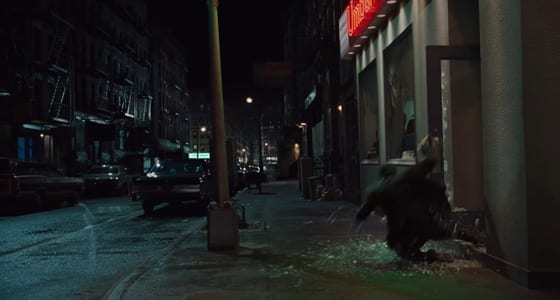
*** 57th New York Film Festival***
The future of a past
On at least two occasions during The Irishman, the latest work by Martin Scorsese, the camera tracks forward between the exterior and the interior of a location, “crossing” a car windshield in one of them, and the glass door of a diner in the other. The movement recalls a very well-known shot from Orson Welles’ Citizen Kane (1941), in which the camera cranes over a building, passing through the El Rancho neon sign toward a sky window, seamlessly dovetailing to the interior of the room where reporter Jebediah Leland (Joseph Cotten) takes another step toward the meaning of “Rosebud.” Welles smoothes out the impossible passage between two separate spaces with a rainy transition; in The Irishman, the glass magically disappears when the camera gets close, erased by a digital dissolve. That clear yet solid physical separation no longer stands in the way of technology; gone is the threshold between might and matter.
Citizen Kane is a paradigmatic movie for a multitude of reasons, but the aforementioned window scene has become a staple in film scholarship not really for its narrative function, but for the combination of technical and artistic prowess that bends the possible, striking the audience with its very exhibitionism. Using Ismail Xavier’s theoretical tent poles of “transparency” and “opacity,” what matters in moments like this one is not the transparency that gives access to the plot (the characters themselves will carry the mystery of Rosebud to their graves), but the opacity of the artistry – what Tom Gunning located as the hegemonic mode of address in early cinema under the rubric “cinema of attractions.” Citizen Kane stands at the intersection between the curls of dramatic depth and the thrills of pure appearance. In its rendering of Charles Foster Kane’s enigmatic life, the narrative spiral is complemented by outbursts of self-sufficient narration, shuffling the “what” and the “how.”[1]
It might sound strange that Scorsese’s latest film recalls the term “attractions” – one that was originally conceived for the scholarship on early cinema, but that has found an afterlife in recent blockbusters. As a historical agent, The Irishman advertises the many ways it looks and pushes forward, whether it is for its use of cutting-edge technology, or for the model-bending affiliation with Netflix. In fact, a preoccupation with historical time is also at the core of the film’s story. Like Kane, this is a biography which includes meaningful interventions in North American history. But, here, there is no mystery to be deciphered. Unlike Kane, Frank Sheeran (Robert De Niro) has survived, leaving behind little more than a trail of blood. The film establishes this right at the opening, with a long take in the nursing home, taking us past the nurses and patients all the way to the spot an elderly Sheeran has parked his wheelchair. As part of the dramatic structure, the shot introduces a place and a rhythm that contrasts with the present immobility of the narrator; as an attraction, the long Steadicam shot recalls a famous moment in Goodfellas (1990), underline the connection between the two films beyond their subject matter. What comes next is not so much a teleological investigation, but a more immediate access to the very fabric of time.
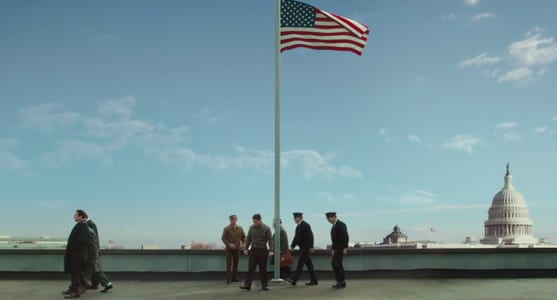
The Irishman (2019), Martin Scorsese
As the film’s clever freeze-frame title cards make the point, halting the early 1970s action to include the date and cause of death whenever a new character is introduced (“died with three shots in the face in 1999”), Sheeran is one of the very last survivors of a world where the difference between life and death is itself barely significant – the gangster world, the nursing home, but also the world of cinema. And as most of the ticketbuying world eagerly awaits for the premiere of the latest film by Martin Scorsese in living rooms across the globe, this transit between life and death, which flows undisturbed now that digital technology can easily get rid of the invisible separation that kept them apart, sets the tone of the film: as a self-reflexive work of cinema, this is both funeral and birthday, a celebration of timeliness and timelessness.
But then again, isn’t the paradoxical experience that collapses the clear distinction between life and death one of the most fascinating aspects of cinematic time, displaying the past as present, “like bees in a glass hive” (Jean Cocteau)? By the grave of Hollywood, a scene with Al Pacino suggests a different angle to that paradox. That scene, however, is part of a different film: Quentin Tarantino’s Once Upon a Time in Hollywood (2019). It takes place at a bar, in the first act of the film. Pacino plays Marvin Schwarz, a casting agent who advises the actor Rick Dalton (Leonardo Di Caprio) – the star of the 1950-television series Bounty Law – to follow Clint Eastwood’s steps and accept lead roles in Italian Westerns instead of playing the villain on big American productions. In that moment when a model of existence and an economy of visibility is under the threat of obsolescence, the expertise of the casting agent relies on recognizing the diegesis as porous, much like Scorsese’s glass windows: when the audience sees a character played by Rick Dalton getting his ass kicked on TV by a new rising star, they’re also seeing the downfall of Rick Dalton himself, the actor.
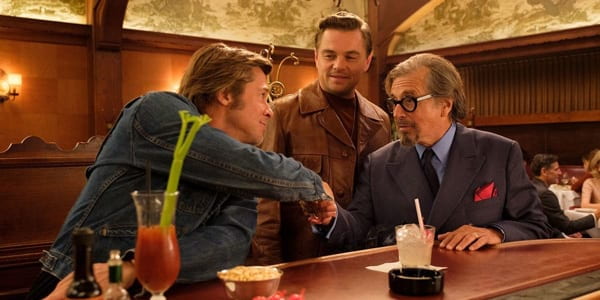
Once Upon a Time in Hollywood (2019), Quentin Tarantino
Cut back to the premiere of The Irishman at the 57th New York Film Festival, and the red carpet repeats the mantra fed by marketing strategies that point to the past: “a new Goodfellas;” “Scorsese’s greatest hits;” De Niro, Pesci, and (finally) Pacino. The first batch of reviews hardly suggests different readings of this narrative, crystalized by the presence of the great ensemble of stars at the press conference that followed the film’s premiere. The film wears its making on its sleeve, pushing what might as well be the very last breath of the star system front and center – which includes the brand of the auteur. It is a work that relies more on “showing” that on “seeing”: when Rick Dalton is on screen, one can only hope that whatever character he’s supposed to be playing does not get in the way. Fruition becomes intransitive: Pacino does not play Jimmy Hoffa; Pacino simply plays.
Despite walking on shallow waters, the film’s duration might trigger namedrops of a myriad of great Russian novelists. The fact that it is long does not make it deep. There are enough narrative bandaids to give the viewer something to follow, as the historical backdrop projects relevance over a story that the mise-en-scène seems to purposefully undermine with its many loose beginnings, false clues (i.e. the whole subplot with Anna Paquin’s character tries to add a dramatic dimension that the film seems to organically reject), and the incessant travel through time. Instead, the film flourishes on the glass surface of the lens itself. Whether it is through the audiovisual assault of a riveting slow-motion fistfight to the melody of Santo & Johnnie’s “Sleepwalk,” the self-evident use of time-curbing special effects that makes one wonder “how did they do that?,” and the unrestricted joy of great actors with plenty of air to shape, this is a film where bodies become paint.
This embrace of a radical opacity in the mise-en-scène is not exactly a surprise in the recent work of Martin Scorsese. The Irishman merely takes one more step in a process that has been on the march at least since Gangs of New York (2002). However, it is precisely the step that makes the whole trajectory clear. Like a biography, each piece adds up until the stars align; The Irishman merely blows the clouds that had been blocking the view.
Except that the biography, here, also gets jammed at the surface, saying very little about Sheeran – a character who seems to have few ambitions, and even fewer regrets – but a lot about cinema’s ability to inspire the dead – dead landscapes, dead spaces, dead practices, dead eyes. As the film negotiates with the real bodies of real actors playing real characters, a younger, digital version of De Niro recalls the image of a young Orson Welles playing an aging Kane. The two films intersect again, not because one keeps pushing forward while the other looks back, but because they are both as invested in the gusts of time as they are on the effects they have on different surfaces.
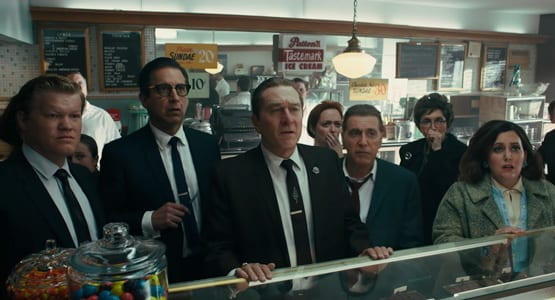
The Irishman (2019), Martin Scorsese
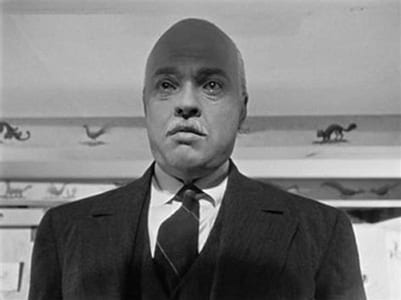
Citizen Kane (1941), Orson Welles
In the film’s many flashes – both forward and back – Scorsese uses the jaded motif of the dying old man recalling his life to imagine the future of a past. This past is not, as in Pedro Almodóvar’s latest Pain and Glory (also screening at NYFF), the sentimental journey through a man’s affective landscape; it is a survey of an entire economy of seeing and showing that has always been punctuated by shifts and substitutions, itself moved by a vertovian dynamism, born joined at the hip with the specter of “the modern.” And the modern is always dying, and always getting born again, because the modern is in fact that very process of death and rebirth, of lights going on and off, filling dark spaces with light and color. This past is cinema as we know it, and, at the edge of cinema-as-we-know-it, awaits the cinema that is yet to be defined.
Perhaps The Irishman is indeed the last exemplar of a dying breed, a requiem for a mode of production ironically paid for by its disappointed child who can’t wait for it all to be different. Considering Tarantino and Almodóvar, this anxiety seems to be in the air. But the film also carries the energy of a new beginning, not as much for its groundbreaking technology, but for the way it imagines “attractions” only the present can afford. When Gunning first coined the term “cinema of attractions,” the relationship between early cinema and the avant-garde seemed to rest primarily on their shared “fascination for the potential of a medium.” With his latest film, Scorsese’s vision of the end paradoxically takes him back to the beginning, revelling on that same fascination, that dizzying pleasure of taking baby steps once again, with a world not behind him, but in front of him.
[1] Ismail Xavier. 2008. O discurso cinematográfico: a opacidade e a transparência. Rio de Janeiro: Paz e Terra. Tom Gunning. 1982. “The Cinema of Attraction(s): Early Film, Its Spectator and the Avant-Garde,” republished in Wanda Strauven (ed.). 2006. The Cinema of Attractions Reloaded. Amsterdam University Press. 381-88.






Leave a Reply